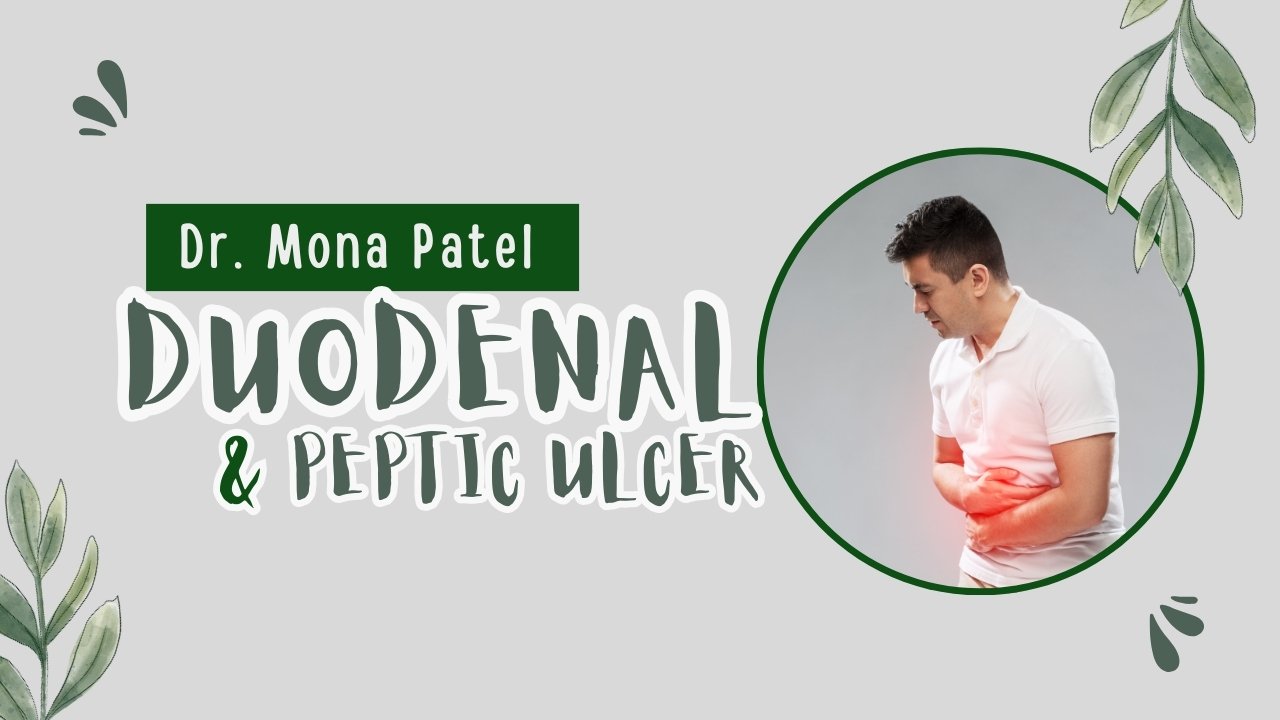Duodenal and Peptic Ulcer
Ulcers

Today, we will discuss ulcers, focusing on their causes, types and natural medical treatments, as well as reviewing related medical reports. Ulcers are sores or sores that develop on the skin or mucous membranes, most often found in the stomach or small intestine. They can also appear in the hands, feet, and mouth at some point in our lives.
Our primary focus will be on peptic ulcers, particularly in the stomach lining or duodenum. Ga strick peptic ulcers are formed in the stomach, while duodenal peptic ulcers occur in the duodenum, the first part of the small intestine. Ulcers in the digestive tract often feel like severe acidity and can cause symptoms such as tingling sensations, abdominal pain, and neck pain. Peptic ulcers are formed in the lining of the stomach or duodenum due to the digestive action of pepsin and stomach acid.
Understanding the causes of ulcers involves exploring the body’s physiology and defensive mechanisms. The body has several defenses against ulcers, including
- Bicarbonate Production
- Layers of mucus
- Prostaglandins
- Mucosal blood flow
- Epithelial renewal.
These defenses help protect and repair the lining of the stomach and intestines.
However, ulcers can develop when these defenses are overwhelmed by invasive factors. The most common cause is the bacteria Helicobacter pylori (H. pylori). Non-steroidal anti-inflammatory drugs (NSAIDs), painkillers, some
- Heart medications
- pepsin
- Stomach acid
Can also contribute to the formation of ulcers. Lifestyle factors such as smoking and alcohol consumption can further aggravate ulcers.
In summary, ulcers arise from an imbalance of aggressive factors such as H. pylori and protective mechanisms in the stomach lining. Understanding these factors helps in the effective treatment and management of ulcers, including naturopathy and other holistic approaches. Ulcers occur as a result of an imbalance between the body’s defensive mechanisms and aggressive factors. When aggressive factors such as:
- NSAIDs
- pylori infections
- Alcohol
- bile salts
- pepsin damage
the upper layer of the mucus membrane, it causes injury to the epithelium. These factors degrade the protective mucus layer and contribute to the formation of ulcers.
Initially, ulcers may begin as local injuries or skin breakdowns due to minor factors. When the recovery phase is disrupted, or neuropathy promotes further damage, internal muscles degenerate, leading to dry skin and inflammation. Bacterial colonization can then occur, leading to increased inflammation. Stress—whether physical, psychological, or environmental—also plays an important role in inflammation and subsequent ulcer development.
Over time, this inflammation can lead to scarring, changes in tissue structure, and changes in muscle and blood circulation in the affected area. The result is an injury to vasculopathy, which manifests itself in the form of ulcers .Cysts are not common unless these mistakes and imbalances are repeated. Several risk factors contribute to the development of ulcers. Lifestyle choices such as smoking and acidic drinks, as well as consuming certain medications, increase the risk. H. pylori infection is another important risk factor, often spread through fecal-oral routes. Maintaining good hygiene is important in preventing H. pylori infection. Age also plays a role, with individuals between the ages of 30 and 40 being more susceptible.
In summary, ulcers develop when aggressive factors overpower the body’s protective mechanisms, leading to epithelial injury, inflammation, and eventual ulcer formation. By understanding and mitigating these risk factors, the occurrence of ulcers can be significantly reduced.

Duodenal ulcers
Duodenal ulcers are more common than gastric ulcers, particularly in older women. Gastric ulcers tend to occur more frequently after the age of 50, as the aging process slows metabolism and increases the likelihood of ulcer development. It is essential to stay active to reduce these risks. Genetic factors also play a significant role; individuals with a family history of ulcers have three times the risk of developing them. Stress is another major factor, complicating the management of ulcers in today’s fast-paced lifestyle.
Ulcers can occur at any age, but men between 30 to 40 years old have a higher risk of developing duodenal ulcers, while those aged 50 to 60 are more prone to stomach ulcers. Gender differences also exist; duodenal ulcers are more common in men, whereas peptic ulcers are more frequent in women. In terms of occupation, both men and women have similar risks.
The symptoms of ulcers can vary. Epigastric pain and discomfort are common indicators. Stomach ulcers often cause pain immediately after eating, while duodenal ulcers typically cause pain 2 to 3 hours after eating or at midnight. Duodenal ulcer patients frequently report hunger, often feeling hungry multiple times a day. Conversely, peptic ulcer patients feel relief after eating, though they may experience pain later. Vomiting provides relief for peptic ulcer patients but is uncommon in duodenal ulcer cases. The duration of ulcer symptoms can last from one to two months, with a few weeks of vomiting in some cases. Duodenal ulcer patients tend to maintain their weight, whereas those with stomach ulcers may experience weight loss. Bleeding is less common in duodenal ulcers, occurring in about 40% of cases. In terms of dietary habits, duodenal ulcer patients generally have a good diet and find relief after eating, while stomach ulcer patients experience discomfort and tend to eat cautiously.
In summary, understanding the different types of ulcers, their risk factors, and symptoms is crucial for effective management. Maintaining a healthy lifestyle, managing stress, and staying informed about family medical history can help mitigate the risk of developing ulcers.

Peptic ulcers
Peptic ulcers often present with more noticeable bleeding compared to duodenal ulcers. Symptoms of these ulcers vary and are typically discussed separately. Diagnostic investigation for ulcers involves several tests. Stool examination for faecal occult blood and complete blood count (CBC) are common tests, which can reveal decreased blood cells, indicating the presence of an ulcer. Additional tests include endoscopy, a procedure where a camera is used to visualize the esophagus, stomach, and duodenum. Endoscopy, also known as EGD (esophagogastroduodenoscopy), is crucial for diagnosing ulcers and potential cancers.
Alarm symptoms indicating the need for endoscopy include:
- difficulty swallowing (dysphagia)
- persistent indigestion
- fatigue while eating
- unexplained weight loss
- Vomiting
- breathing difficulties
If patients exhibit these symptoms, further investigation is warranted. Peptic ulcers can lead to complications such as hemorrhage, where blood vessel damage occurs, and perforation, where the stomach or duodenal wall muscle splits open, causing severe vomiting and black stool. This indicates an unhealthy condition, as bacteria and partially digested food can accumulate, leading to further complications such as infections and narrow obstructions in the stomach.
If not treated promptly, ulcers can lead to significant health issues, including penetration of the ulcer into other organs like the pancreas and liver. This can cause scarring, swelling, and a narrowing of the stomach, leading to vomiting and potentially stomach cancer. Therefore, it is crucial to manage ulcers with lifestyle modifications, drug therapy, and, if necessary, surgery.
Management of ulcers includes lifestyle modifications and drug therapy. Hypo-secretory drugs, such as barium and antibiotic tablets, are commonly prescribed. Surgery is recommended if the ulcer worsens. In naturopathy, the focus is on lifestyle changes to manage ulcers. Patients are advised to avoid NSAID drugs, which are often prescribed for conditions like:
- Diabetes
- thyroid issues
- heart problems
- Emphasizing lifestyle modifications
- natural treatments
is essential in managing and preventing ulcers.
Comprehensive Approach to Managing Peptic Ulcer: Integrative and Naturopathic Treatments
Peptic ulcer disease presents a significant challenge, requiring a holistic approach that combines traditional medical treatments with naturopathic therapies to effectively manage symptoms and promote healing. This integrative strategy not only targets the root causes but also enhances overall well-being, addressing lifestyle factors that exacerbate the condition.

Medical Management
Peptic ulcer disease typically involves addressing Helicobacter pylori infection, managing excessive stomach acid production, and mitigating the effects of NSAIDs. Conventional treatments include antibiotic therapy for H. pylori, acid-reducing medications, and lifestyle modifications such as smoking cessation and dietary adjustments.
Naturopathic Interventions
- Diet and Hydration:
- Emphasizing alkaline foods and adequate water intake supports mucosal lining integrity and reduces acidity levels, crucial for ulcer healing.
- Specific diets tailored to individual needs can alleviate symptoms and aid in cellular regeneration.
2. Stress Management:
- Addressing various stressors (work, personal, familial) through relaxation techniques, yoga, and mindfulness can significantly reduce inflammation and improve healing outcomes.
- Naturopathic Therapies:
- Mud Therapy and Hydrotherapy: Application of mud packs and hydrotherapeutic techniques not only relieve pain but also promote circulation and alleviate muscle tension associated with back pain common in ulcer patients.
- Heliotherapy (Sun Therapy): Exposure to sunlight aids in Vitamin D synthesis, essential for immune function and possibly protective against ulcerative complications.
- Complementary Modalities:
- Acupuncture and Acupressure: Stimulating specific points can help regulate gastric acid secretion and alleviate pain.
- Yoga and Deep Relaxation: Practices like Yoga Nidra and specific asanas promote relaxation, reduce stress-induced acidity, and aid in overall ulcer management.
Integrative Care in Practice
Integrating these approaches offers a comprehensive treatment plan that not only targets the ulcer itself but also enhances the patient’s overall quality of life. By combining conventional medicine with naturopathic therapies, healthcare providers can optimize outcomes, reduce recurrence rates, and empower patients in their healing journey.
Conclusion
Effective management of peptic ulcer disease requires a multifaceted approach that considers both medical and naturopathic perspectives. Educating patients about these integrated therapies empowers them to make informed decisions about their health, promoting not just symptom relief but long-term wellness and prevention of complications.
In conclusion, adopting an integrative approach to peptic ulcer management not only addresses the immediate symptoms but also fosters a supportive environment for healing and overall health improvement. This comprehensive strategy represents a proactive step towards holistic patient care in gastroenterology.






